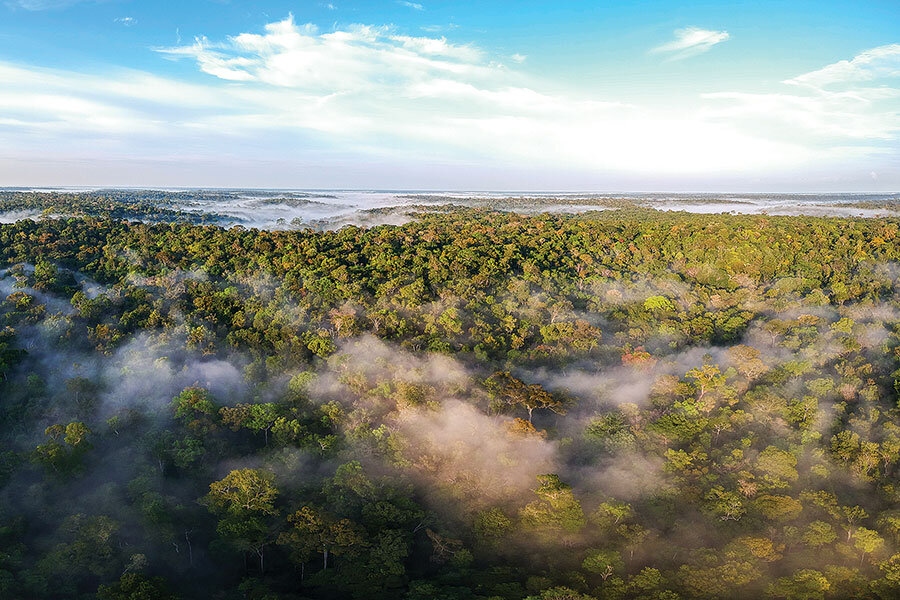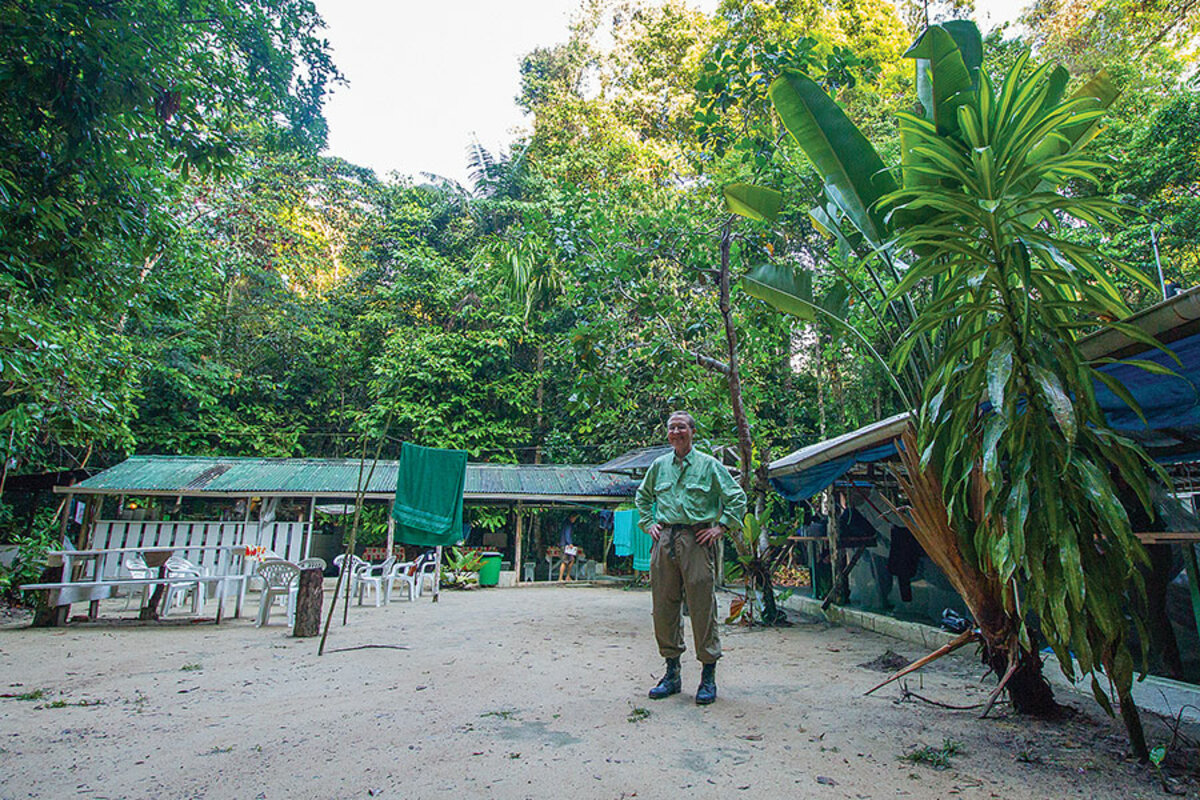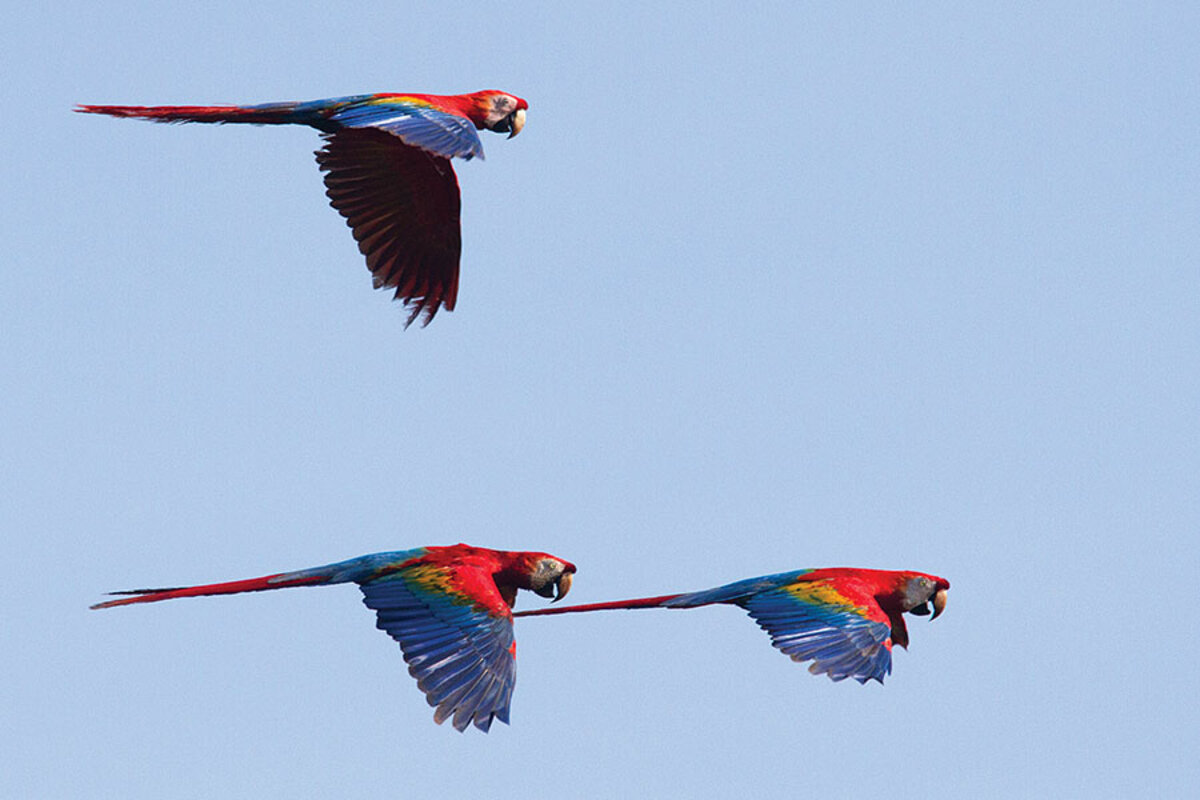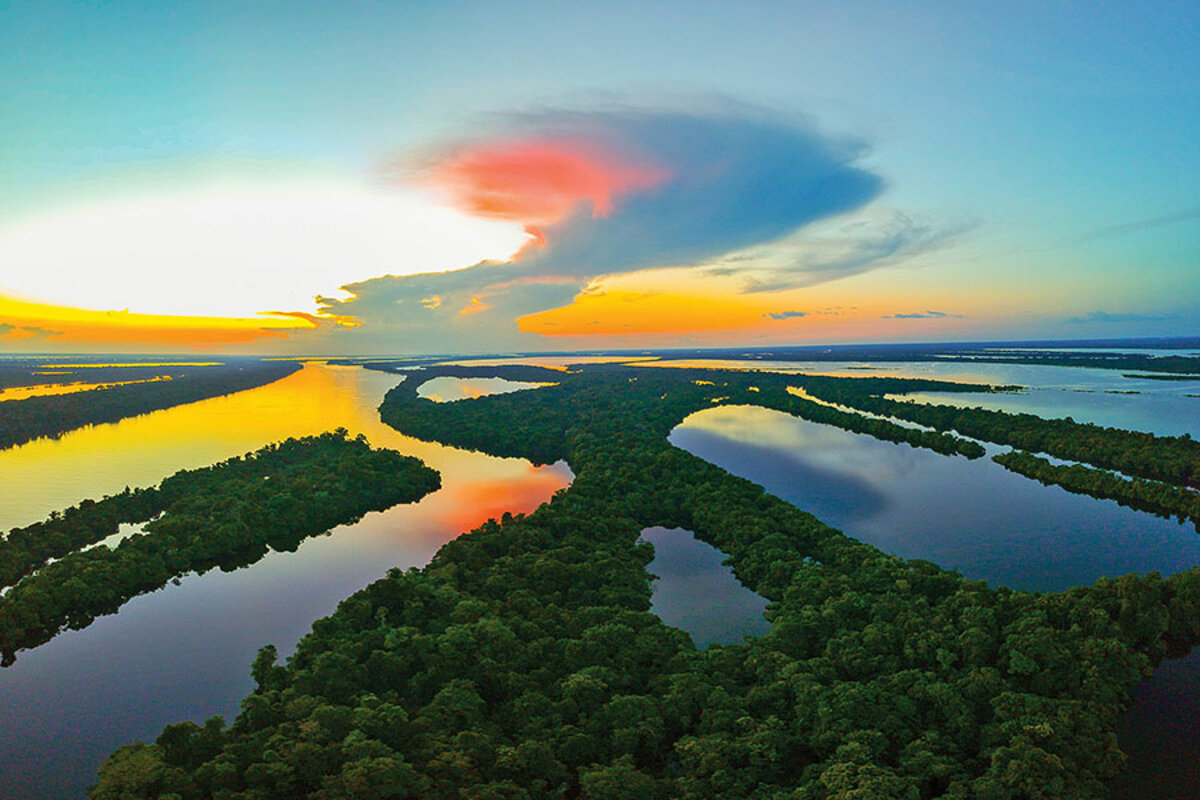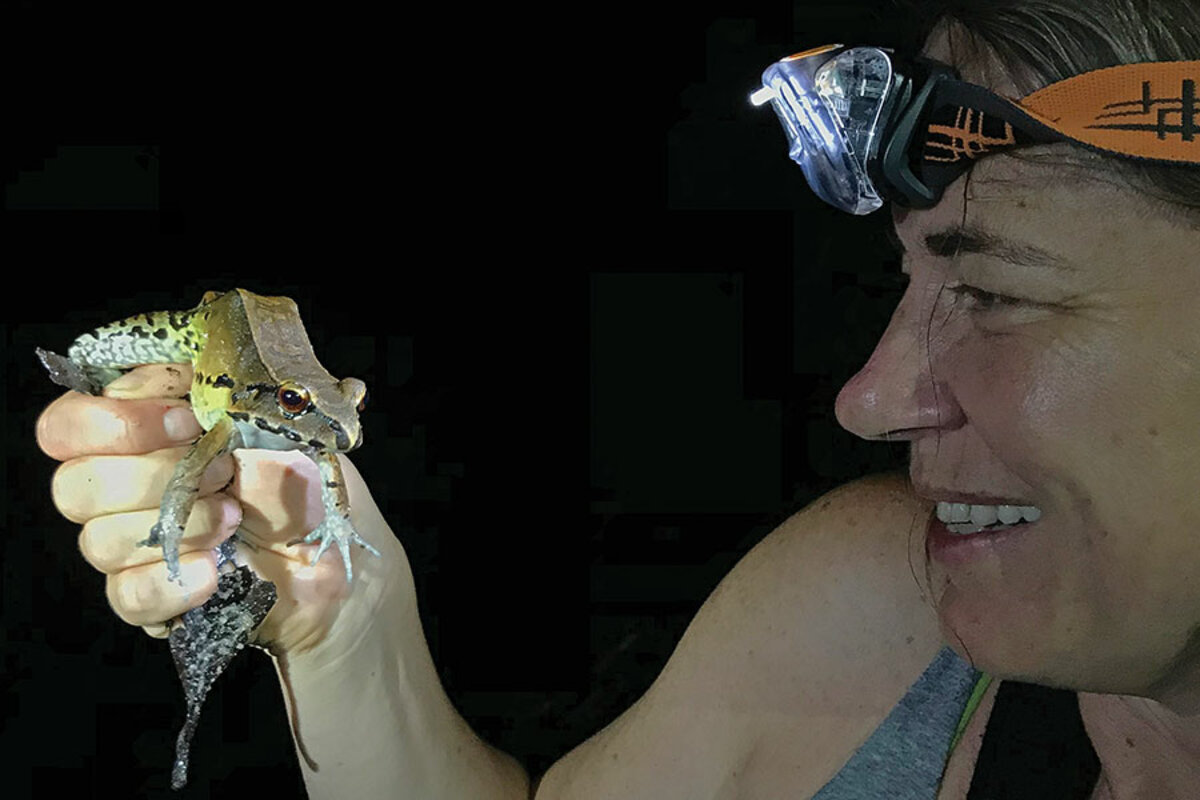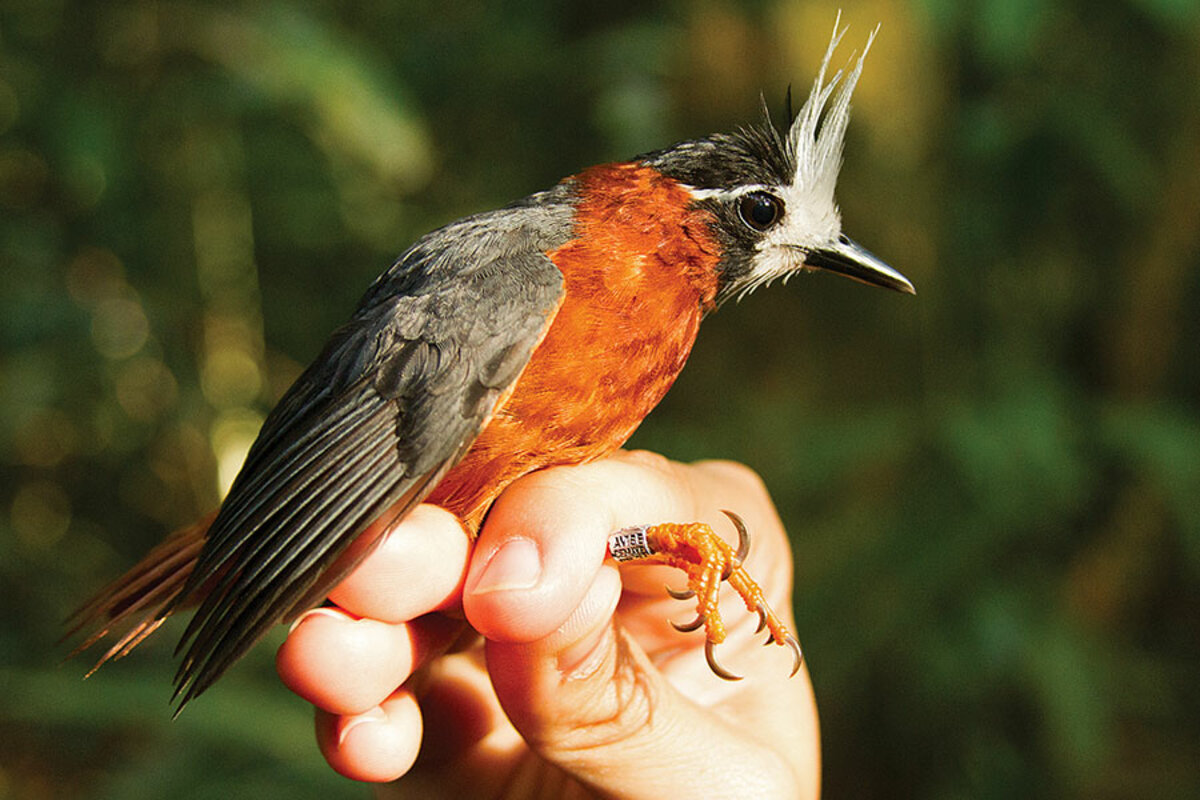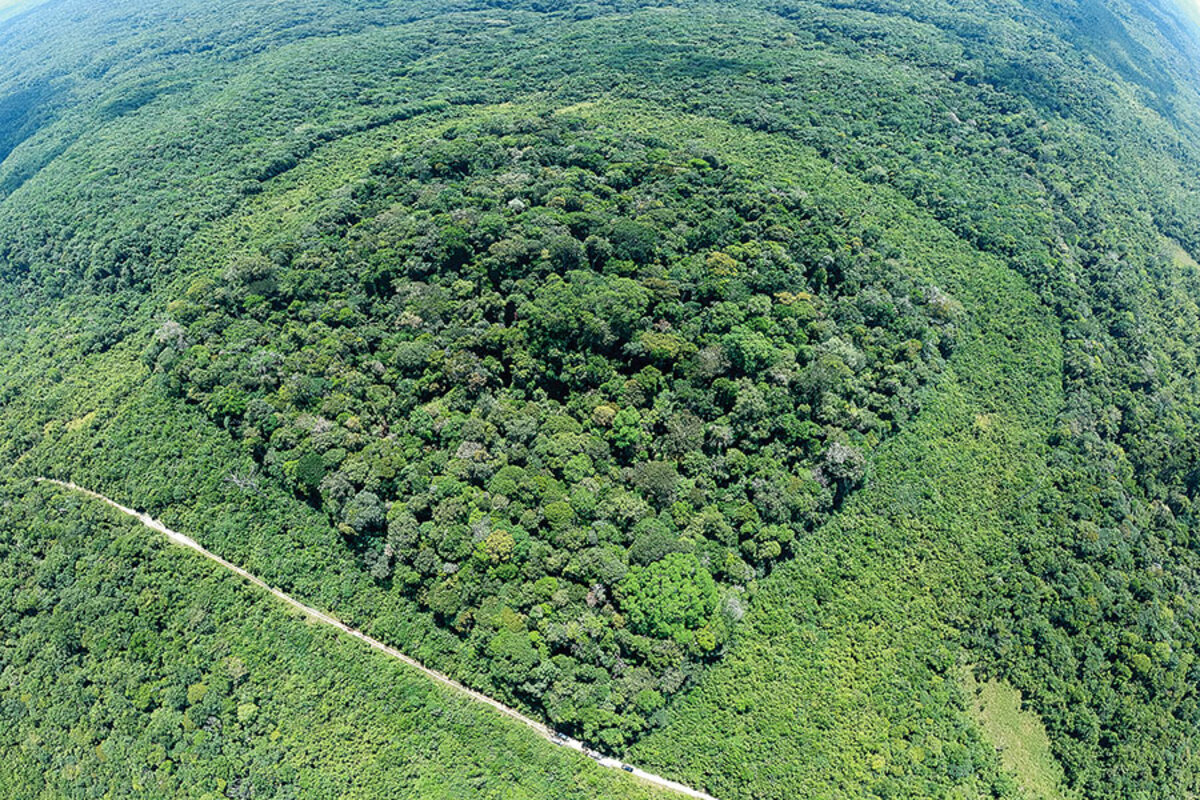Camp Amazon: Inside the 'lungs of the Earth'
Loading...
| Camp 41, Brazil
We hear the high-pitched call long before we see any movement. Looking for life in the most biodiverse landmass on the planet requires a surprising amount of patience. And sharp eyes. While the piercing whistles make it clear an ornate hawk-eagle is nearby – to someone, at least, who knows the hundreds of different birdcalls found in this section of the Amazon – the thick trunks and lianas and bromeliads of the rainforest make seeing anything frustratingly difficult.
Our eyes strain upward, searching, until finally, we’re rewarded with the sight of a magnificent black-crested bird swooping silently through the canopy to land on a branch bathed in light. We gaze in awe as it trains its own sharp eyes on the two-legged intruders in its world.
The setting: Camp 41, a handful of tin-roofed, open-sided structures deep within the world’s largest tropical wilderness and home base for hundreds of ecologists conducting research over the past 39 years. We’re 50 miles north of Manaus, Brazil, 25 miles up a rough dirt road, and a half-mile hike into primary Amazon rainforest, a dark, dense understory of green beneath a canopy of trees more than 150 feet high.
Why We Wrote This
So much of the climate change story is reported from a high altitude. For this piece our writer burrowed beneath the Amazon canopy to get face-to-face with some of what’s at stake.
It’s a place that feels enveloped by the pulsing life of the planet.
I’m here with Thomas Lovejoy, a legendary ecologist and “godfather of biodiversity,” who in 1979 began a research project – of which Camp 41 is part – to gather long-term data on the effects of breaking up eco-rich habitat.
Over the years, Dr. Lovejoy, an environmental science professor at George Mason University in Fairfax, Va., has often brought guests – ranging from scientists to senators, CEOs to celebrities (Tom Cruise, Olivia Newton-John) – to sleep in hammocks at this iconic camp and gain an appreciation for the richness and diversity of the Amazon rainforest. On this trip, he’s come with some dozen visitors interested in conservation. As an environmental journalist, I’m tagging along hoping to get an understanding of what role this forest plays in two of the biggest environmental crises facing our planet: climate change and biodiversity loss.
Nearly 20 percent of the world’s river water flows in the Amazon basin, and it covers an area of about 3 million square miles – nearly the size of the lower 48 states. While 60 percent of the Amazon lies in Brazil, it also extends into seven other countries, plus the territory of French Guiana. It’s one of Earth’s most important environmental filters, a lush expanse that sucks carbon dioxide out of the atmosphere to use in photosynthesis and thus helps prevent the buildup of heat-trapping gases.
The Amazon “is the largest terrestrial repository of biodiversity on the planet,” says Lovejoy. “And it has a tremendous amount of carbon in it which we do not want to end up in the atmosphere. On those two counts alone it adds up to a really high priority.”
Ominously, he and other scientists also believe it’s nearing a tipping point: If much more deforestation occurs in the Amazon, the hydrological cycle that supports it could be upset, endangering the entire planet.
“It’s really part of the continental climate system,” says Lovejoy. “And that’s not a very sensible thing to mess around with.”
***
Most people have at least a vague notion of what the Amazon is. It looms large in Hollywood films and our imagination, often figuring as a sort of insect-infested jungle, teeming with venomous snakes and piranha-filled waters, a backdrop to explorers who hack away at vines with machetes while fending off beasts.
The reality is both less and more than that vision.
Much of the Amazon is remarkably benign. In the week I spent in Brazil, sleeping in hammocks in Camp 41 and then exploring the flooded forests along the Amazon and Rio Negro rivers, I didn’t use insect repellent, barely saw a mosquito, and received nothing worse than a few chigger bites. Yes, there are snakes, but despite lots of searching, we never found one. The nutrient-poor soil in many parts of the rainforest means that, despite being the world’s most biodiverse landmass, there isn’t the abundance of life people expect. Spotting birds can be hard, spotting mammals even harder. Most of the evidence of that teeming richness is auditory.
But the abundance is there, nonetheless. The forest itself is a dense backdrop of dozens of shades of green, so thick that just 1 or 2 percent of sunlight filters down to the forest floor. It’s a finely calibrated and uniquely stable environment that allows life to flourish in complex relationships. In the area around Camp 41, one 2.5-acre area of rainforest might have 250 core species of birds and 320 different kinds of trees. Nearly every bird, insect, and amphibian has developed unique features and habits that help each play a specialized role in the system.
Take army ants. Swarms of them rove the forest floor, eating whatever they find. A suite of bird species has evolved that follows them – not to eat the ants, but to eat all the creatures flushed out by the ants. Certain butterflies, meanwhile, follow the birds that follow the army ants, sucking nitrogen from their droppings.
“That kind of complex interaction among many species is one of the classic things that we associate with the rainy tropics in general and that reaches its real culmination in the Amazon,” says Mario Cohn-Haft, an ornithologist who works for the National Institute of Amazonian Research in Manaus.
Dr. Cohn-Haft first came to Brazil in the mid-1980s as an intern on Lovejoy’s fragmentation research project. Other than a few years back in the States for graduate work, he’s never left. The rich environment, the opportunity for new discoveries, and the Brazilian culture – including the Brazilian ecologist he married – all “conspired to seduce me completely,” he says.
Now one of the top ornithologists in the Amazon, Cohn-Haft exudes an infectious enthusiasm for the ecosystem that goes well beyond birds. His facility for music – he was a member of his college a capella group and occasionally breaks out into classic American songs – translates to a remarkable ability to recognize and imitate birdsongs, from the liquid coo of the plumbeous pigeon to the distinctive wail of the screaming piha. His research has been instrumental in the realization that many birds assumed to be the same species but with radically different calls are, in fact, different species.
As a guide to understanding the rainforest, Cohn-Haft is superb. On our first walk around Camp 41, he hears and then calls in – either with his own voice or using a Bluetooth speaker – dozens of birds: trogons, macaws, toucans, antwrens. But he also interjects a stream of tidbits about the forest and its inhabitants. Each section of the Amazon, he tells us, has two types of toucans that live in it, a “yelper” and a “croaker.”
He points out a passion flower and then a “hemiepiphytic” tree, which starts its life in branches before sending down roots to the forest floor. We spot termite tunnels, the trails of giant earthworms, a troop of bearded saki monkeys, a tortoise shell from which a jaguar has taken a large bite. When we see a paradise jacamar, Cohn-Haft tells us about its long, narrow beak.
“These guys – they do these dives in the air where they predict where their prey item’s going to be, and then for the last adjustments they make this incredibly fast movement of the tip of their bills, and they can just snatch insects that other things can’t catch,” he says.
That night, amid a chorus of loud frogs and cicadas, we use headlamps to spot spiders, huge cane toads, and an opossum high up in a tree. When we turn the lights off and allow our eyes to adjust, bioluminescent fungus on dead leaves turns the forest floor into murky constellations – an underfoot planetarium. During the night I hear a thundering cascade of rain pounding the roof above my hammock, and later the echoes of a troop of howler monkeys passing through camp, and drift off feeling part of an incredible web of life.
***
Looking out over the forest canopy from a 130-foot high tower in the Amazon, it’s easy to see why these dense forests are critical beyond the wealth of species that reside in them. They’re also a vast carbon repository.
Between 90 and 120 billion tons of carbon are stored in the Amazon Basin – equivalent to a decade’s worth of carbon emissions from cars, power plants, and other industrial sources.
The Amazon’s ability to absorb more carbon than it emits (making it a carbon “sink”) has counterbalanced all the carbon emissions from the nine Amazon nations since the 1980s, according to some research, but its ability to be a sponge is declining.
For climate scientists, that makes it both an important part of climate-change solutions as well as a potential threat, should the denuding of the Amazon’s forests increase significantly.
One of the biggest concerns: at what point the Amazon, or parts of the Amazon, might reach a “tipping point,” past which the lush ecosystem – which generates about half of its own rainfall – ceases to exist.
Models differ on the severity of the threat, and there are a number of unknown factors – including fires and drought, which have been an increasing problem in recent years. But the potential is there, especially in the eastern Amazon, says Daniel Nepstad, executive director of the Earth Innovation Institute. “It’s the area of deforestation beyond which you start to inhibit rainfall so much that ... clearing leads to more drought, which leads to more fire and rainfall inhibitions as you lose vegetation,” Dr. Nepstad says.
Since 2000, the region has been hit by three unprecedented droughts, which led to substantially worse fires. “There’s this 90 billion-ton pool of carbon leaking out slowly with deforestation, and the potential for large belches of CO2 going into the atmosphere through forest fire is very, very real,” says Nepstad. “It’s actually happening; it’s not a hypothetical thing. Whether or not that locks us into a brand new climate in the Amazon [with half of the region dominated by grasslands instead of forest] remains to be seen, but it’s a potential.”
Early models indicated 30 or 40 percent deforestation might make the ecosystem break down and turn parts of the southern and eastern Amazon into savanna. Now, Lovejoy and others believe those other intrusions – climate change and fire – may have pushed the numbers down to 20 or 25 percent. And 17 percent of the Brazilian Amazon is already gone. Whatever the precise threshold, scientists don’t want to test it. “Nobody knew at the time of the Dust Bowl that those last trees they were cutting would push them over the edge,” says Lovejoy.
Currently, with a largely intact forest, the Amazon provides huge climatic benefits that scientists are only beginning to understand. The moisture generated in the Amazon produces rainfall in the Andes Mountains, and parts of it move south and north, down to cities and agriculture areas in southern Brazil, Paraguay, and northern Argentina.
It sends rainfall all the way up to the Midwestern United States, right when farmers are planting, says Adrian Forsyth, a tropical ecologist who is the president and co-founder of the Amazon Conservation Association. “There’s this trillion-dollar subsidy of rainfall coming to agricultural and urban areas that people simply didn’t know about until recently,” he says.
***
Lovejoy is soft-spoken and thoughtful, with a broad smile and an understated sense of humor. In the rainforest – which he acknowledges feels like home – he always wears socks pulled over his long pants to protect against chiggers, the one species for which he says he might be hard-pressed to mount a conservation effort.
It can be easy to underestimate him at first meeting, but hard to overestimate the influence he’s had on conservation. Lovejoy was the one who, in 1980, coined the term “biological diversity.” He is an authority on extinction projections, travels as a science envoy for the US State Department, and originated the idea of debt-for-nature swaps – reducing a country’s financial obligations in exchange for protecting the environment.
In the late 1970s, Lovejoy suggested a long-running experiment in the forests around Manaus looking at the effects of fragmentation on the ecosystem. At the time, a debate was raging about whether it was better to have a single large protected area or several small ones. The supporters of patchwork protection argued that myriad smaller plots might be less susceptible to threats and support more diversity. Lovejoy, then head of the World Wildlife Fund’s US operations, saw an opportunity in a Brazilian law that required certain cattle ranchers to reserve 50 percent of their land as forest. He designed an experiment monitoring a number of isolated fragments of varying sizes: 2.5 acres, 25 acres, 250 acres. The results – though the experiment is still ongoing – have been conclusive: Bigger is better.
“Large blocks are necessary for large predators, and when you take those out of the system, the whole system starts to unravel,” says Dr. Forsyth.
Researchers found that a 250-acre fragment loses half of its bird species in 15 years. The carbon density of the forest, in turn, changes when the species critical to dispersing seeds leave. They also discovered significant “edge effects,” in which trees dry out and die, light and wind penetrate the trees, and the forest in effect collapses.
“It’s pretty dramatic,” Lovejoy says.
As we walk into one 25-acre fragment, it still looks like a dense forest, but it’s eerily quiet. No monkeys reside here. We hear some cicadas and the distinctive call of the screaming piha, but otherwise the forest seems largely devoid of life. Even the trees in these individual plots grow more slowly. “It’s imploding over time,” says Cohn-Haft.
Ultimately, Lovejoy believes it takes at least 400 square miles for an Amazon rainforest to be stable – a finding that has influenced Brazil and other countries in their conservation efforts over the years.
***
It takes leaving the forest of Camp 41 to grasp just how diverse the ecosystems within this tropical wilderness are, even in this one small section around Manaus.
The mighty Amazon River itself and the Rio Negro tributary are both edged by miles of várzea forest – huge swaths that are regularly flooded as their waters rise and fall by as much as 50 feet a year. The “muddy” waters of the Amazon contain large amounts of sediment and support specific trees and animal species. Certain birds – like the pearly-breasted conebill we spot one day – live only on the river islands that regularly form as sediment builds up.
In these turbid waters, we find a few giant waterlilies, the legendary plant whose round leaves can grow to more than nine feet in diameter and support a small person. Lovejoy regales us with stories not just of the lily’s fascinating biology – it traps a certain beetle overnight in its flower before releasing it covered with pollen – but of its contributions to modern architecture. Joseph Paxton, an English gardener and architect, built the famous Crystal Palace in London in 1850 inspired largely by the ribs and girders of the lily. “Half the buildings of the modern world mimic giant water lilies,” Lovejoy says.
The ecosystem of the Rio Negro is its own separate world. The várzea forests here have different trees and consequently different birds, insects, and amphibians. The river and its tributaries are lower in nutrients and more acidic – one reason for the almost total absence of biting insects – and it’s possible to drink straight from the river.
As we drift in canoes through the várzea forests of the Anavilhanas Archipelago, we watch red, yellow, and black wire-tailed manakins conduct intricate courtship dances among the play of light in the trees.
Off a smaller tributary to the Rio Negro is yet another ecosystem: a white-sand savanna. Oppressively hot and humid, the forest here shrinks down to shorter trees and shrubs that can withstand the sandy soil and poor drainage. These savannas are found throughout the Amazon basin and support a completely different array of species. But the diversity of these smaller worlds also contributes to the region’s vulnerability.
“The [roughly] 20 percent deforestation is not uniformly distributed across the Amazon. It’s mostly in a few parts,” says Cohn-Haft. “Thirty years ago when I got to the Amazon, there were no bird species that anyone in good conscience would call endangered. Now some birds are critically endangered, on the brink of extinction.”
The loss of life in this teeming world is worrisome for more than just biological and climatic reasons. It also affects peoples’ pantries and medicine cabinets. Tens of thousands of different species of trees alone grow in the area, and just a handful – including cashews, pineapples, cacao – have been tapped for human use. Lovejoy points out that the venom from the bushmaster snake was the basis for a huge class of drugs for high blood pressure.
“You’ve got hundreds of millions of people living longer and more productive lives with no clue where this idea came from, and never putting a dollar value on it,” he says. “Every species is a set of solutions to a set of biological problems, and any one of those at any time can become transformative to the life sciences.”
***
I leave the Amazon in awe of its intricacy and vastness and with a new appreciation for the degree to which the magnificent diversity of life here affects the whole planet.
The threats to that delicate balance are numerous. Brazil has created an impressive network of protected areas for both conservation and indigenous peoples and has reduced its deforestation rate nearly 80 percent since its peak in 2004. But it is now facing significant political and economic instability. Brazil’s currency has lost value, making soybean plantations, which are hacked out of the forests, more economically compelling. Conservation is often a low priority for a government in turmoil.
When Lovejoy first traveled to Brazil in 1965, one highway existed. Now numerous roads penetrate the rainforest, each leading to significant development and more deforestation. Dams create problems both by stopping the flow of critical sediment and blocking migratory fish.
But there are also reasons for hope. In many ways, it’s remarkable that such a vast ecosystem has remained largely intact. In 1965, Lovejoy notes, one national park in Venezuela and one indigenous park in Brazil were the only protected areas in the Amazon. Now, about half the basin is protected.
“It’s the biggest roadless wilderness in the world, with fewer roads than Siberia,” says Forsyth. “It’s still there, waiting for us to protect it.”
Lovejoy also sees potential for development that could help economies thrive while not harming the forest: sustainable cities that don’t draw on the forest for productivity, ecotourism, better designed dams, transportation that relies on rivers, not roads.
“There are hopeful possibilities,” says Lovejoy. The key, he says, is that it has to be managed as a whole, “so that all that great repository of biodiversity remains intact. Because it does operate as a system.”




